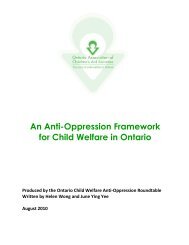English - Ontario Association of Children's Aid Societies
English - Ontario Association of Children's Aid Societies
English - Ontario Association of Children's Aid Societies
You also want an ePaper? Increase the reach of your titles
YUMPU automatically turns print PDFs into web optimized ePapers that Google loves.
population relates primarily to the legal recognition in 1992 by unanimous<br />
resolution <strong>of</strong> the House <strong>of</strong> Commons and Senate and the definition <strong>of</strong> Métis in<br />
the Powley case <strong>of</strong> 2003.<br />
From the very beginning <strong>of</strong> European contact in North America, Métis peoples have<br />
existed. The joining <strong>of</strong> European, primarily French settlers, and Native cultures<br />
created a distinct and unique culture separate from both parent cultures.<br />
While the Constitution Act in 1982 recognized the Métis as Aboriginal peoples, the<br />
legal definition was not clear until the Powley court case in 2003. The case involved a<br />
claim by two members <strong>of</strong> the Sault Ste. Marie Métis community, Stephen Powley and<br />
his son Rodney, who were asserting their Métis hunting rights. The Supreme Court <strong>of</strong><br />
Canada outlined three broad factors to identify Métis right-holders:<br />
> > self-identification as a Métis individual<br />
> > ancestral connection to an historic Métis community<br />
> > acceptance by a Métis community<br />
All three factors must be present for an individual to qualify under the legal definition<br />
<strong>of</strong> Métis, but there is still a great deal <strong>of</strong> ambiguity. There continues to be challenges<br />
to the Métis falling under the “Aboriginal” definition with the government denying<br />
access to services and programs.<br />
HISTORY OF MÉTIS<br />
Apihtaw’kosisan means a sort <strong>of</strong> half-son. This was translated into <strong>English</strong> as<br />
Halfbreed. To the Ojibway, we are mixed-blood. They say wisahkotewinowak which<br />
translates to mean where the fire has gone through and burnt everything, and new<br />
shoots come up from the ground. That’s where the Métis come from; they were the<br />
new Nation, the new shoots that come up from the ground from Mother Earth<br />
(McCallum as cited in NAHO, 2008).<br />
“Distinct Métis settlements emerged as an outgrowth <strong>of</strong> the fur trade, along freighting<br />
waterways and watersheds in the Prairie provinces. In <strong>Ontario</strong>, these settlements<br />
were part <strong>of</strong> larger regional communities, interconnected by the highly mobile<br />
lifestyle <strong>of</strong> the Métis, the fur trade network, seasonal rounds, extensive kinship<br />
connections and a shared collective history and identity.”<br />
A distinct mixed-blood population began to emerge, who were neither European<br />
nor Indigenous. Intermarriage among other mixed-blood people began to produce a<br />
separate linguistic and cultural community by the early 1800s. Because <strong>of</strong> the active<br />
involvement <strong>of</strong> this new, distinct mixed-blood population in the fur trade, their<br />
population grew and their culture strengthened over time.<br />
The Métis flag bears the infinity symbol which represents the coming together <strong>of</strong> two<br />
distinct and vibrant cultures, those <strong>of</strong> European and indigenous North America, to<br />
produce a distinctly new culture, the Métis. The flag symbolizes the creation <strong>of</strong> a new<br />
society with roots in both Aboriginal and European cultures and traditions.<br />
53

















